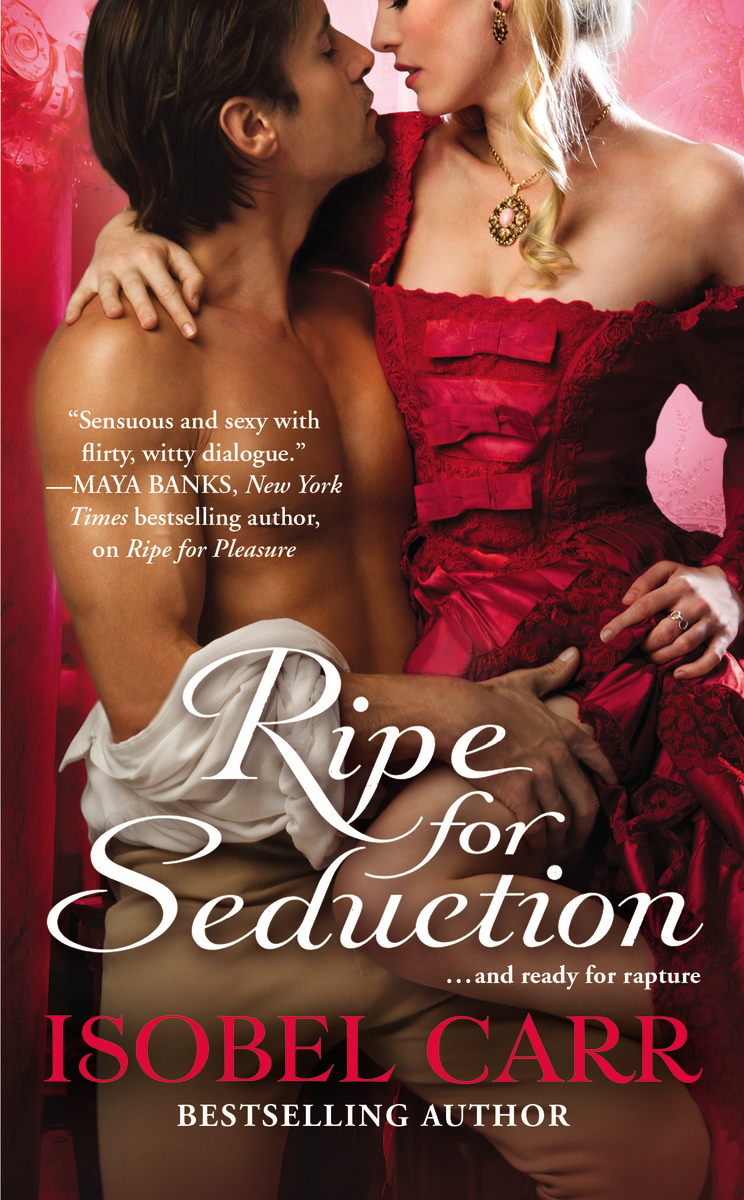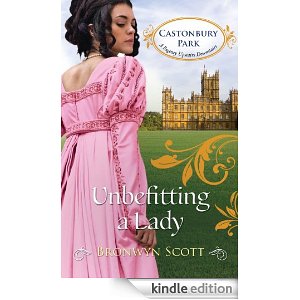Today, author Isobel Carr visits the Riskies to talk about her new book, Ripe for Seduction, answer some questions, and give away some books. Check it out, because she’s being very generous. Details on how to enter at the end of this post.
About Isobel Carr

Isobel Carr
Isobel grew up participating in a wide variety of historical reenactment clubs (California Renaissance Faires, the Society for Creative Anachronism, Heyercon, Dicken’s Faire, Gaskills, etc.). On top of these clubs, she and her friends recreate 18th century fashions just for fun. Isobel has spent large parts of her life studying the manners, customs, and clothing of multiple periods (most specifically Renaissance England and Germany, Georgian/Regency England and France, and Victorian England), and she has firsthand experience creating and wearing the clothes of these eras (including the correct underwear and corsets!). Because of her interest in living history, and that hobby’s strong focus on the details of daily life, she hopes she has an unusual and intimate perspective on history that gives extra life to her books.
Find Isobel at her website: www.isobelcarr.com
On Twitter: @isobelcarr
On Facebook: https://www.facebook.com/isobel.carr
Ripe for Seduction

Cover of Ripe for Seduction
After the scandalous demise of her marriage, Lady Olivia Carlow knows the rakes of the ton will think her fair game. So when a letter arrives bearing an indecent offer from the incorrigible Roland Devere, she seizes the opportunity. Turning the tables on the notorious rogue, she blackmails him into playing her betrothed for the season. But no matter how broad his shoulders or chiseled his features, she will never fall prey to his suave charm.
When Roland boasted he’d be the first into Lady Olivia’s bed, he couldn’t have imagined that behind those brilliant blue eyes lurked a vixen with a scheme of her own. Still, Roland is not about to abandon his original wager. If anything, learning that the lovely Olivia is as bold as she is beautiful makes him more determined to seduce her into never saying “never” again.
Get your hands on Ripe For Seduction: Amazon
What they’re saying about Ripe For Seduction:
Starred review from Publisher’s Weekly!
Carr is sure to balance her characters’ roguish antics with genuine heart, making the double love story a delightful and erotic page-turner.
4-Stars (RT Book Reviews)
For her third in the League of the Second Sons, Carr delivers not one, but two love stories that will charm and titillate readers. It’s intriguing that, at times, the more mature romance overshadows the younger couples love story, but it is the underlying passion in both, as well as the marvelously crafted backdrop, that holds readers’ attention. You will be easily drawn into the naught and bawdy era through Carr’s deft prose.
Five Fun Facts
The indecent offer my hero, Roland, makes to my heroine was based on one a real one made to Lady Mary Coke. The real-life lord got off easier than my hero, LOL!
Giant dogs, this time Scottish Deerhounds, once again put in an appearance. Deerhounds were a very rare breed by this point in history. It’s doubtful that most people had ever even seen one, but luckily for us all, a few people kept the breed alive. I am lucky enough to know several Deerhounds, as they frequent my local dog park. Watching them run across the field is truly a sight to behold. The Wolfhounds and Great Danes can’t keep up with them, and the Greyhounds are simply dwarfed by them.
RIPE FOR SEDUCTION features a shallop race on the Thames. The Queen’s Jubilee, with its display of historical boats, couldn’t have been more timely.
I based the house they all end up at in Paris on one that I stayed at in the Marais. Just down the street is my favorite Parisian café, Le Bouledogue, where you can meet Didier and his adorable French Bulldogs. Order the duck. You won’t be sorry.
After you’ve finished RIPE FOR SEDUCTION, you can read the reconciliation scene for the secondary couple on Ripe for Seduction’s page on my website. I deleted it from the novel to keep Margo and Philip from taking over, but it’s a scene I really love, so I kept it as a bonus for readers.
Excerpt!
You can download the first three chapters here (Word doc).
Q. Tell us about the series:
The League of Second Sons was a writers’ lunch burst of inspiration. I knew I wanted to write about a group of younger sons, men who would be hungrier, less secure, and have entirely different issues to wrestle with than their elder brothers. After the passage of the Marriage Act in 1753, the easy path of heiress abduction was essentially cut off (marriage under duress now being voidable) and this created even greater scope for setting up interesting plots. Add into it their banding together in the fight to claim what they can in a world that gives everything to the eldest brother, and you have a solid, interesting subset of the ton that most would be essentially unaware of as a force.
Q. We are all about author pet pictures. I understand you have a dog. A very large dog. Can you tell us about him? Does he help you write? Do you have a picture of him?

Clancy: Photo by Isobel Carr (All Rights Reserved)
Oh, Clancy is perhaps the most well documented dog that doesn’t belong to William Wegman. He has his own gigantic Flickr page (along with his sisters, Slag and Tallulah, who belong to my sister and best friend respectively). http://www.flickr.com/photos/49097059@N00/3283805430/sizes/s/in/set-72157607307911869
He’s half Neapolitan Mastiff and half Bullmastiff and 175lbs of cuddly sweetness. Mostly, it’s like living with a lion. Mostly he’s napping (bed, couch, dog bed), but he’s defiantly aware of what’s going on around him. As for “helping” me write, not so much. He like likes to lay on the couch behind me and sigh gustily as I ignore him in favor of “petting” the evil glowing box. But he and his sisters were the inspiration for Pen, the dog in the first League book, so I guess he does help after all, LOL!
Q. Based solely on clothing alone (that is do not account for the status of women or minorities etc.) What time period would you most like to live in and why?
Mid to late 18th century. I love the clothing from about 1750-1790. Love, love, love it! The hoops and silks and hair (ok, not the 1770s hair). There’s a reason I set my books in the 1780s (my all time favorite decade for fashion).
Q. I have heard you say you like men with big noses. Like who?
Oh, I do. There’s nothing like a really nice, distinctive nose. Julian Sands, Joe Manganiello, Adrian Brody, Richard Armitage.
Q: Red-headed heroes. Go.
I love red-heads. Love ‘em. I can’t wait to write one (Leo, in Ripe for Pleasure is a red-head, but my editor made me change all the references to “auburn”). But I see Eric Stoltz, Domhnall Gleeson, David Wenham. Yum!
Q: Fill in the blank:
You walk into an antique store and you get short of breath because right there is a Limbert rocker. When you look in your wallet, you have enough money to purchase it. What is the item and why does it make you short of breath?
Well, mostly because we’re going to pretend I have that kind of money in my wallet. I own a 1916 Arts and Crafts bungalow, and one of the pieces of furniture I COVET for my living room is a genuine rocker from that period. The Stickley ones are nice, but there’s a Limbert one that I saw once in a local antique store that just called to me. The clean lines, the amazing quarter-sawn grain of the oak, the heft and solidness of it. That beautiful chair could hold up to being knocked about by my giant dog. Unfortunately, it was six grand.
Q: Corset vs. brassiere. Go.
Corset! I really do loathe the way a bra digs into my ribs. Corsets don’t do that, and if you lace them just snug, they’re really very comfortable. But I’m not yet ready to be the eccentric author who wears a corset every day…
Q: Your book is going to be a movie! Who do you cast?
Roland was based on Hal Ozsan. He played the witch in Supernatural “The Curious Case of Dean Winchester” and I just found him mesmerizing to watch. I love how dark he is, and how his hair curls. And yes, he has an amazing nose! Evidence that Isobel is right?
For Olivia, I pictured a young Rosamund Pike. I loved her as Lady Harriet in Wives and Daughters. There’s something really strong about her, but also a hint that she could shatter under the right circumstances. She’s an actress I just really enjoy watching.
Q: What’s next for you?
Next is Marcus Reeves’s book, Ripe for Revenge, which will be my first foray into self-publishing:
Running has always served Caro Frazier well. It worked when her parents disapproved of her chosen groom, when her husband took umbrage at his young wife’s social success, and when circumstances forced her to flee London altogether. But when her past comes back to haunt her—in the delicious form of Marcus Reeves—running is the last thing on Caro’s mind.
Marcus Reeves never expected to see—never wanted to see—Caroline Frazier again, not after he saved her when her husband cast her off and then she abandoned him too. He certainly never expected to discover her living in a quiet, rural hamlet with a child who is unmistakably his. Whatever her reasons for betraying him, she’s his now, and Marcus is ready for a little revenge . . .
Giveaway
Isobel is giving away 3 copies of her new book and one full set of the series for a new to her reader! Yes. That’s four winners. Woot!
Rules: No purchase necessary. Void where prohibited. International is OK, provided The Book Depository ships there. The winner will be picked at random from among qualified comments. Leave a comment on this post by midnight Pacific Thursday December 20. To be eligible for the full set of the series, mention whether you are new to Isobel’s books. Feel free to tell us about your pet, or the antique store item that would have you palpitating.






.jpg)

